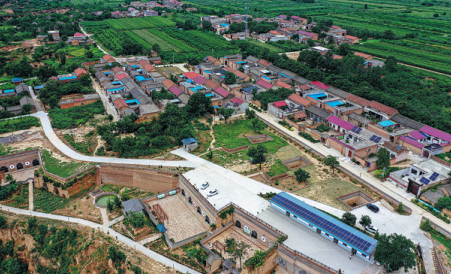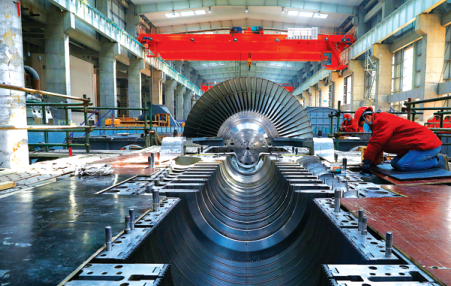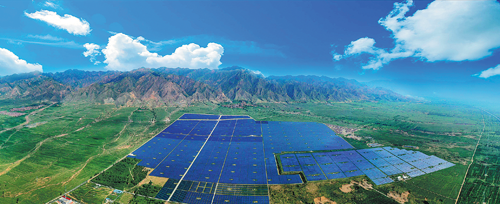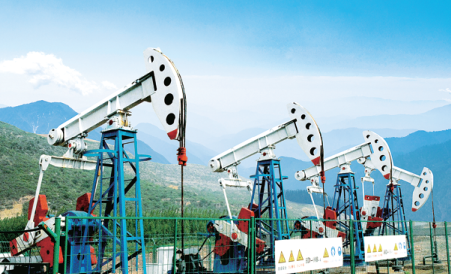Shanxi pushes energy revolution full steam ahead
Updated: 2021-09-03

Zhuangshang in Ruicheng county is a "zero-carbon" village recognized by the United Nations Development Programme because of its use of clean energy. [Photo by Xiao Yongjie for China Daily]
Province in North China working toward using more sustainable sources
A low-carbon energy development forum opening on Friday in Shanxi's capital city of Taiyuan will become a showcase of Shanxi's latest efforts and achievements in sustainable growth, the event's organizers said.
According to Wang Ligang, deputy secretary-general of the two-day forum's organizing committee, the event, which is also known as Taiyuan Forum among industry insiders, is being held both offline and online.
Wang said it is the first high-profile forum in China's energy industry since Chinese authorities proposed the country's goal for carbon peaking in 2030 and carbon neutrality in 2060.
With a theme centering on energy, climate and the environment, the forum will discuss topics including energy revolution; carbon peaking and neutrality; and ecological civilization. Participants include government officials, industry experts and business representatives from home and abroad.
Wang said the event displays the Chinese authorities' determination to promote low-carbon development and their willingness to enhance international cooperation in this field.
Shanxi's achievements in the energy revolution are a highlight of the event, according to Wang.
As Shanxi used to be a leading coal producer in China, its reliance on coal and related heavy industries had caused a number of challenges to its social and economic development, including low growth rates and pollution.
To address the challenges, Shanxi began to implement a transformation plan to reduce its reliance on coal, upgrade traditional industries and foster high-tech and emerging sectors as new growth drivers.
The energy revolution, which involves promoting the development of clean energy resources and upgrading coal-related industries toward the direction of more efficient and cleaner production, is a major part of Shanxi's economic transformation plan, according to Wang.
The official said the latest achievements in energy revolution and low-carbon development made by various cities in Shanxi are also a highlight of the event.
Changzhi

Workers assemble clean power generation machinery at a manufacturing plant in Zhangzi county. [Photo by Liu Feng for China Daily]
The city of Changzhi in the southeast of Shanxi is among the pioneers of the province proposing an implementation plan for energy revolution.
The plan, including 44 measures for 10 industrial fields such as smart mining, clean coal production and solar power development, has clarified the city's direction and path toward carbon peaking and neutrality with clear timetables, road maps and well-defined responsibilities of government institutions and businesses.
According to the scheme, a total of 61 new energy projects have been planned for Changzhi's energy revolution, including facilities for the production of coal-based new materials; resource recycling; power generation near coal mines and power generation using clean energy resources; as well as smart power transmission grids and energy storage.
There are also projects in the research and development for energy revolution, in cooperation with the nation's renowned universities like Tsinghua and research institutions including the Chinese Academy of Sciences.
Of these, 58 projects with a combined investment of 74.61 billion yuan ($11.49 billion), including a smart coal mine funded by Lu'an Group and a photovoltaic component plant invested in by Rishengda Corp, were listed as the province's key projects.
Datong

The county of Tianzhen in Datong is known for its booming solar power industry. [Photo by Tian Zhong for China Daily]
The efforts of Datong in northern Shanxi in energy revolution highlight the balance between developing new, clean energy resources and upgrading the coal mining industry toward the direction of clean and efficient production.
On the barren hills in the village of Shiren in the city's Yunzhou district, a huge solar farm is what local residents are pinning their hopes on for increasing family incomes and reducing poverty.
"More than 1,000 low-income families like mine are closely linked to this solar farm, as it is designed for poverty alleviation," said Zeng Shiguo, a local resident. "It brings in about 3,000 yuan to every household involved on an annual basis."
The solar farm is funded by Longji Green Energy Technology.
Longji Green Energy Technology is among the first companies in Datong to be engaged in new energy development. It has invested in four large-scale solar power stations and three production plants for producing photovoltaic components and power-storage facilities in Datong.
The city of Datong has also made efforts to upgrade its coal mining industry by phasing out outdated capacities and promoting clean production. It fulfilled its goal in the industrial upgrading program in 2019, with more than 60 percent of its coal production capacity reaching advanced levels featuring automation, modern operations, efficient production and lower emissions, according to local officials.
Supporting Datong's energy revolution are a number of high-tech zones in the city, focusing on R&D in new energy resources and smart production. The zones are home to 10 research institutions funded by the CAS and led by 28 top scientists.
Jincheng

Mining equipment is installed in Qinshui county for extracting coalbed gas. [Photo by Kong Lei for China Daily]
The city of Jincheng in the southeast of Shanxi has focused its efforts on upgrading the coal mining industry for an energy revolution.
Its latest five-year plan for the coal industry required the phasing out of all the coal mines with a capacity of less than 600,000 metric tons a year and the goal was achieved at the end of 2020.
In addition, there are 27 medium and large-sized coal mines which have shifted their operations from coal mining to the production of lower-emission resources like coal bed gas and coal-based chemicals.
Upon the completion of the phasing out and transformation programs, the city's industrial regulators recently proposed an action plan to promote the smart operations of coal mines.
Jincheng has established a citywide database to guide the intelligent production of coal mines. Changping and Sihe No 2 are the two pilot coal mines that have completed automatic and intelligent mining operations. Projects to promote smart mining are now underway in another 151 mining shafts, which are expected to be completed in the following several years, according to local officials.
Lyuliang
Lyuliang city in western Shanxi is one of the pioneers in the province using 5G communications technology to equip its coal mines for smart and safe production.
Xinyan Coal Mine operated by Dongyi Group, for instance, was among the first companies in Shanxi to digitalize its coal mining with 5G in 2020.
"With a 5G network reaching every shaft, all the production processes, including mining, conveying, drainage and safety monitoring, can be controlled at our smart operational center," said Mei Jun, chief engineer of Xinyan Coal Mine.
Mei said the intelligent operation has led to a saving in labor cost of about 30 million yuan a year. In addition, the improved efficiency can also help to slash the operational cost by 15 yuan per ton of coal produced.
The city's industrial officials said the digitalization of another two coal mines is underway, which include 128 mining shafts.
The city has also seen steady growth in the production of cleaner energy resources. Its output of coalbed gas reached 1.27 billion cubic meters in the first seven months of this year, growing 131 percent year-on-year. Construction of a 100,000-megawatt wind power station is underway, which is expected to begin operation at the end of the year.



